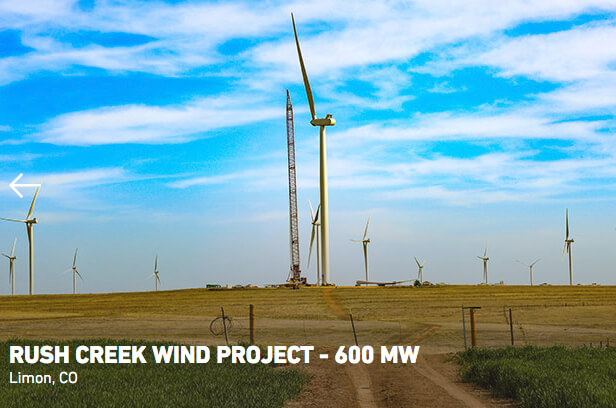
Xcel selected Mortenson to construct the Rush Creek Wind Project The scope of work included building access roads, foundations, collection system installation, O&M building, erection and wiring of 300 Vestas’ V110 2.0 MW wind turbines.
Xcel Energy announced that it has completed construction work on its Rush Creek Wind Project, including 300 turbines and a related 80-mile-long transmission line. It is set to bring the facility, the first large-scale wind farm owned and operated by the company in Colorado, into commercial operation by October 31.
The Rush Creek Wind Project, a significant component of Xcel Energy’s “Our Energy Future” initiative in Colorado launched in 2016, is a 600-MW, company-owned wind farm and a related 345,000-kilovolt transmission line, which extends over 95,000 acres in parts of Arapahoe, Cheyenne, Elbert, Kit Carson and Lincoln counties in eastern Colorado. When completed, it will be the largest wind farm in the state.
The facility, which will come in on schedule and under budget, will provide clean, carbon-free electricity to the equivalent of 325,000 homes in Colorado. The project will eliminate up to one million tons of carbon a year related to its electricity generation, when compared to other traditional generation sources.
“Xcel Energy first mapped out a vision for this wind project in the spring of 2016. Today, we now have a project built to carry clean, affordable renewable power to our customers’ homes and business,” said Alice K. Jackson, Xcel Energy Colorado president, at an event at Rush Creek today. “This project means cleaner air and significantly boosts the renewable power already present in Xcel Energy’s diverse energy mix.”
The Rush Creek Wind Project is expected to inject more than $1 billion into the local economy through the construction and operation efforts. According to the Leeds School of Business at the University of Colorado in Boulder, the wind facility ultimately is expected to create more than 7,000 jobs in Colorado, based on a 25-year analysis. Rush Creek also will result in $180 million in lease payments and local property taxes over the life of the project.
In addition, Xcel Energy customers in Colorado will benefit from the project, particularly by taking advantage of federal tax credits for renewables, which is turn will result in the lowest-cost electricity generation on the Colorado system.
Xcel Energy will be able to reduce generation fuel, operation and maintenance costs compared to other forms of generation, according to the Leeds Study, and will be pass on those savings. It is estimated that the project will save residents and business customers more than $400 million on a net present value basis over the life of the 25-year project.
The project also has strong ties to several companies with Colorado-based operations.
Vestas, a global wind-turbine manufacturers, produced all 300 of the two-megawatt wind turbines at Colorado-based manufacturing plants in Brighton, Pueblo, and Windsor, Colo. Invenergy, which has a regional development office in Littleton, Colo., served as the Rush Creek’s lead developer. Mortensen Construction also served as the general contractor for the Rush Creek Wind Farm.
The Rush Creek Wind Project was approved by the Colorado Public Utilities Commission in September 2016, and was supported statewide by a dozen parties to the regulatory process, and by numerous other state and eastern Colorado entities.
Filed Under: News, Projects





Rush Creek; ~95,000 acres for a 600 MW generating plant. The Diablo Nuclear Power Plant that California is planning to shut down is rated 2,256 MW and is built on ~900 acres. Habitat is apparently not a consideration when it comes to thinking “Green” Wind (and Solar too) Power is it?
Consideration for petroleum based products (turbine blade resins and gear/bearing lubricants) used in the manufacture and construction of the wind generators is also ignored along with the industrial level power and mostly diesel fuel required for mining, smelting, forging, transportation, etc. for the production of copper, steel and concrete. A proper “life cycle analysis” would show the folly of “Green” wind (and solar) energy production. And, don’t forget disposal of “end of life” wind generators especially the blades that cannot be recycled and have to be buried thus destroying even more habitat. I suggest you get busy with engineering your next nuclear powered plant…it’s the future.